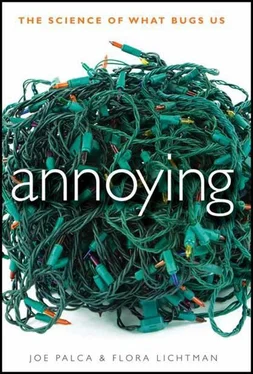The experimenter displays a piece of banana, lowers the board and places the banana under one of the cups. The board is then raised, and working behind it, with his hands hidden from the view of the monkey, the experimenter takes the banana out and deposits a piece of lettuce in its place. After the delay, the monkey is told to “come get the food.” She jumps down from the chair, rushes to the proper container and picks it up. She extends her hand to seize the food. But her hand drops to the floor without touching it. She looks at the lettuce, but (unless very hungry) does not touch it. She looks around the cup and behind the board. She stands up and looks under and around her. She picks the cup up and examines it thoroughly inside and out. She has on occasions turned toward observers present in the room and shrieked at them in apparent anger. {34} 34 2. O. L. Tinklepaugh, “An Experimental Study of Representative Factors in Monkeys,” Journal of Comparative Psychology 8(3) (1928): 197–236.
[Emphasis in the original.]
Unpredictable, temporary, and unpleasant—the monkey must be annoyed, right? Brian Hare is an anthropologist who is willing to consider the possibility. He leads the Hominoid Psychology Research Group, which compares the psychology of hominoids (human and nonhuman apes). Hare’s graduate student Alexandra Rosati has found another activity that reveals what appears to be a tendency in our primate cousins to become annoyed.
She has done a series of experiments with chimpanzees. She offers the chimpanzee a choice. Option A is a guaranteed couple of peanuts. Chimpanzees are fond of peanuts but not that fond. Not as fond as they are of bananas. It’s a cliché, but Rosati says that chimpanzees love bananas. Option B is a chance at a piece of banana—but it’s only a chance. There’s also a chance that they’ll get a chunk of cucumber. Chimpanzees appear to like cucumbers as much as capuchins do; in other words, not much.
No one likes to lose a bet, and chimps, Rosati found, are no exception. When they lose, they try to change their choices, and when they aren’t allowed to, they appear to get annoyed. You could call it anger, but it’s very different from the anger you see when a chimp is attacked.
Rosati has conducted a similar experiment with bonobos. They, too, appear to get annoyed when they choose the gambling option and lose the bet, and getting a bad outcome made them less likely to choose the risky option on the next trial. The individual bonobos who got most upset at losing were the least likely to choose the risky option overall.
Chimpanzees, on the other hand, didn’t seem deterred by losing. They pick the risky option again and again. It seems that for some species, or at least some individuals, the drive to gamble trumps the annoyance of losing.
• • •
When you think about what’s bothering these primates, it can appear, at first glance, to be the road-block kind of annoyance. They have a goal—getting the grapes or the bananas—and the researchers (or bad luck or whatever) are temporarily preventing them from achieving it. Yet there’s more to it than that. In the case of the capuchins, they were happy with the cucumbers until the grapes came along. This isn’t like being stuck in a traffic jam when you have somewhere else to be. It’s more like being cut off by another motorist when you’re out for a leisurely drive. Instead of having their plans thwarted, their sense of what was acceptable behavior was thwarted. It was an injustice, albeit minor.
People (and some animals, apparently) face different kinds of annoyances—based on various kinds of unpleasantness. There are annoyances that are physically unpleasant: a skunk smell, fingernails on a chalkboard, flies buzzing in your ear. Another type of annoyance happens when your plans are thwarted: from delayed flights and forms to fill out in triplicate to birds chirping loudly when you’re trying to sleep to endless automated phone messages thwarting your desire to talk to your doctor. The third and possibly largest category is made up of annoyances we bring on ourselves, either because they violate certain social rules or conflict with our value system or destroy a reasonable expectation. (Of course, some special annoyances fall into multiple categories—cell phone chatter is a social rule violation and botches your plan to read while you’re commuting on the bus.)
An example of this final category comes from Sarah Brookhart, the deputy director of the Association for Psychological Science:
For me, public transportation is teeming with annoyances. Like bacteria on the handrails, the loud one-sided phone conversations about what to have for dinner are part of the deal when you’re in a subway car at rush hour. Put on headphones and tune it out. But I could probably ignore a colony of deadly microbes more easily than I can ignore the guy sitting next to me clipping his fingernails. Cranking up the iPod doesn’t help. Time stands still. Agonizing suspense after each clip. Has he stopped? Or will there be another click of the teeny guillotine? Then, that unmistakable sound, and a half-moon sliver sails through the air in slow-motion. Worse, I can see it land on the arm of the woman across the aisle; she has no clue, but my skin is crawling with disgust. {35} 35 3. Sarah Brookhart, personal communication with the author.
Again, there’s the disgusting component. Bodily sounds, smells, and pastimes gross us out—perhaps because they seem unhygienic, and there are plenty of evolutionary reasons we’d want to avoid sickness.
Yet there seems to be more going on here. Part of what makes this experience annoying is that Sarah chooses not to clip her fingernails on the subway. This is a value-system trespass. There is no law against clipping your nails on the train. You’re expected to be able to put up with that behavior, even though it offends your sensibilities, and this annoys you.
Although breaking social mores seems different from having your tongue burned by a chili pepper, they do have something important in common. For each, there is a thin line between pleasant and unpleasant. An unexpected and minor subversion of your social expectations is also pretty close to the recipe for comedy. Belch loudly at a family barbecue, and you can see for yourself how this works. Everyone in elementary school will probably find this sudden, surprising transgression hysterically funny. Everyone else, annoying. It’s this thin line that Hollywood likes to keep a close eye on.
If science has largely ignored the topic of annoyingness, the dramatic arts have not. Movies and plays are filled with annoying characters, meaning that screenwriters and playwrights have to become de facto psychologists. They have to capture the personality traits of what makes someone annoying and put them into a character that everyone will recognize as annoying.
There may seem to be a paradox here. For the most part, we would normally go to great lengths to avoid spending time with someone who is annoying. Yet watching annoying people from a safe distance can actually be tolerable, even amusing. Surely, there is some guilty pleasure to be had from watching Tina Fey get so annoyed that her head is ready to explode.
Playwright Neil Simon and director Gene Saks clearly recognized that possibility when they made the movie The Odd Couple , starring Jack Lemmon and Walter Matthau. Matthau played the part of Oscar Madison, a slovenly sportswriter. His New York apartment is a mess. The food in his refrigerator is growing mold. He’s divorced, happily so, and is chronically late with his alimony payments.
Jack Lemmon’s character, Felix Ungar, is the exact opposite. He’s devoted to his wife, even though she kicked him out of the house because of his annoying habits. He makes strange noises when he clears his throat. He’s painfully punctilious and a total neat freak.
Читать дальше












